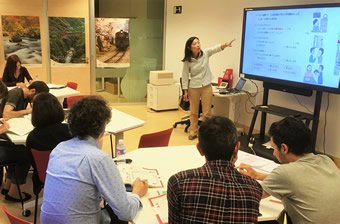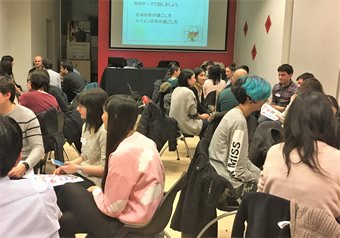Creating a Comfortable Environment in Japanese-Language Courses
The Japan Foundation, Madrid
MATSUSHITA Keiko
The Japan Foundation, Madrid (hereinafter “JFMD”) opened in April 2010 and the two-person team, including the Japanese-Language Senior Specialist and the Japanese-Language Specialist in charge of Japanese-language course, has been providing support for Japanese language education in Spain including advisory services, teacher and learner support, and Japanese-language course management. I joined the team in July 2016 as the third to hold the position of Japanese-Language Specialist in charge of Japanese-language courses. In this report, I will introduce my activities that I have been carrying out in that capacity.
Marugoto Course (Japanese-Language Course) and Goal-Oriented Courses
JFMD offers evening Japanese classes for working adults and university students. We call these classes the “Marugoto Course” due to the use of the “Marugoto: Japanese Language and Culture” as the text. The classes cover five levels, from Starter to Intermediate 2, though the levels of the course actually offered depend on the year. Many of the learners are working adults or university students who attend classes after work or school. Every one of the classes is fun and full of laughter, and one can often hear the students making plans to eat ramen together after class.
In addition to the Marugoto course, we also host short term courses geared towards specific goals. In FY2016, these goal-oriented courses included “Japanese for Travel,” “Japanese for Middle-Aged and Senior Learners,” “Japanese for Secondary School Students,” “Intensive Kanji Class,” and “Intermediate Conversation.” All of the courses are very popular, and some of them even have waiting lists, demonstrating the strong interest that the people here have in the Japanese language and culture. The goal-oriented courses also provide the motivation to start learning Japanese, with students of the course frequently going on to study Japanese comprehensively in the Marugoto course.

The Marugoto course
The learners studying at JFMD have a variety of motivations and goals. Recently I asked one student, who has been attending the courses for six years since they were launched, why they kept coming. They replied, happily, “I can’t really explain the reason, but I love Japan and studying Japanese is simply fun for me.” So, I think the real strength of the Japanese-language course is that they give a comfortable environment where the students can meet others who share their interests and enjoy studying Japanese while communicating with each other in the language. I believe it is invaluable to continue providing a place like that.
Cultural Japanese-Language Course and Japanese Conversation Club
In addition to Japanese-language courses, the JFMD also offers courses to experience Japanese culture and a Japanese conversation club. The Cultural Japanese-language course is designed to leverage the Japanese practice through cultural experience, including communicating with guest Japanese instructors, to increase the motivation of the participants to learn Japanese.
Cultural activities held in FY2016 included a “Kirie class,” in which students designed their own patterns to cut and finish, and a “concert featuring Shakuhachi flute and Spanish guitar” where participants sang Anime songs as well as Spanish songs in Japanese. Surprisingly, the time spent by the instructors introducing themselves was received very well, with some participants commenting that they were glad to hear about the background and lives of the Japanese instructors from their own mouths.
The Japanese conversation club, entitled "Let's Talk in Japanese! Vamos a Nihonguear!” is something that was started by the previous Japanese-Language Specialist in 2014 and that I have continued. May 2017 will mark the 18th gathering of the club to date. The club is open to any learner of Japanese, and in addition to students from our own courses, many students participate who study at other institutions or even on their own. All of the participants, including the Japanese members, seem very satisfied with the club gatherings and there are many repeat visitors.
A topic is set for each gathering for group discussion, but not all topics lead to lively conversation. I realized, after being put in charge of coordination, that in addition to presenting the theme, it was also extremely important for me to play the role of facilitator by adjusting the flow of conversation in each group and building the right atmosphere. There are also students of the classes and library interns who assist as volunteer staff, so it is important to remember that we all must create the events together.

Japanese Conversation Club Vamos a Nihonguear
Future Challenges
Even when unable to attend Japanese classes due to work or other constraints, Spanish learners are continuing their Japanese-language studies individually at their own pace by interacting with former classmates and Japanese people via the goal-oriented courses, the Conversation Club, or cultural classes offered elsewhere. Moving forward, I wish to find ways to support these lifetime learners of Japanese. To that end, I intend to increase the opportunities to participate in a wide range of activities for learners to expand their connections with others, including outside of the JFMD activities.
One future challenge is to provide learning opportunities for intermediate and later learners. While the number of beginner learners is high overall and there are numerous programs for them, the number drops from intermediate and beyond, and there are few programs that focus on those levels. Therefore, I hope to understand the needs of those learners and implement programs for them.
- What We Do Top
- Arts and Cultural Exchange [Culture]
- Japanese-Language Education Overseas [Language]
- Japanese-Language Education Overseas [Language] Top
- Learn Japanese-language
- Teach Japanese-language
- Take Japanese-Language Test
- Know about Japanese-language education abroad
- The Japanese-Language Institute, Urawa
- The Japanese-Language Institute, Kansai
- Japanese-Language Programs for Foreign Specified Skilled Worker Candidates
- Japanese Language Education for Japanese Children Resident Overseas and for the Descendants of Migrants
- Archives
- Japanese Studies and Global Partnerships [Dialogue]
- JF digital collection
- Other Programs / Programs to Commemorate Exchange Year
- Awards and Prizes
- Publications
